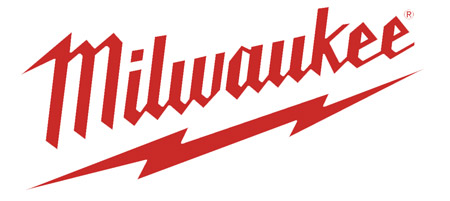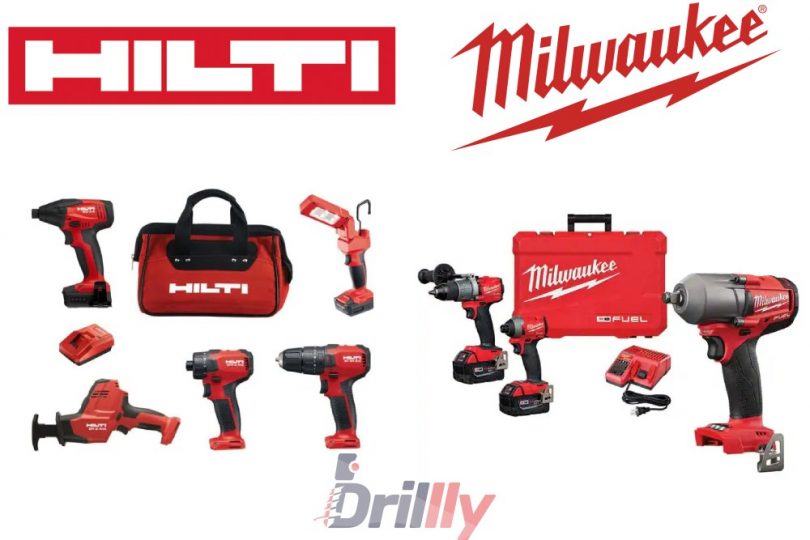It is challenging to choose the best tool for the job with all the brands available these days.
Here we will compare Hilti vs Milwaukee, comparing their product lines and looking at the pros and cons to help you make the best tool choice for your next job.
Hilti or Milwaukee
Who are Hilti

Martin and Eugene Hilti started Hilti in 1941 after acquiring the patents for their actuated-nail gun and impact tools. They entered the international sales scene in 1952 with the DX 100, the world’s first powder-actuate tool.
Hilti was doing business in 30 countries by the 1960s. After the death of Eugene Hilti, the company had continued growth. Hilti introduced the first mechanical anchor system and electro-pneumatic hammer drill at the end of the 1960s.
The Kaufering, Germany, plant began their foreign manufacturing and required an executive board to form in the 1970s. The Martin Hilti Family Trust emerged in the 1980s, with Hilti well established in the US, Africa, Europe, and Asia.
Martin’s son Micheal became CEO in 1990 and expanded their markets to Russia and South America. Martin Hilti died in 1997.
Economic change in 2009 created a leadership change at Hilti and resulted in one-billion-dollar in revenue in North America in 2015.
Hilti currently has 11 plants worldwide, specializing in specific manufacturing, such as heavy-duty diamond tools in California; Cutting discs, cup-wheel, large blades, core bits in India; and direct fastening elements (nails) and metal anchors in Liechtenstein.
Who are Milwaukee

A.H. Petersen developed one of the first versions of a compact drill in 1924 at Henry Ford’s request.
The drill could handle heavy jobs but was light enough to be used one-handed.
Petersen was in Business with Albert F. Siebert when they lost the A.H. Petersen Company to a fire. Siebert bought the remaining company assets at an auction and turned them into Milwaukee Electric Tool Company.
Most of their money was made in tool repair despite the drill’s success. Milwaukee used the knowledge they acquired from the tool repairs to design better tools focusing on the automotive and metalworking industries.
With the quality improvements, they began manufacturing new lighter-weight tools: a lightweight version of their hammer drill, grinders, sanders, and electric hammers that became popular in the 1930s.
IN WWII, the US Navy used their drill when Milwaukee manufactured their planes.
They released their reciprocating saw in the 1950s and began adding a vast line of 18V cordless tools of contractor-grade
The original Wisconsin manufacturing plant is still in use. Over the last decade, they have acquired a manufacturing plant in Hong Kong and have factories in China where their M18 FUEL and NonFuel tools are manufactured.
They currently own several brands including, Dirt Devil, Ryobi, and Hoover, and continue to manufacture in the US from several locations.
Tool Lines Offered
Hilti
Hilti offers a big variety of tools for the everyday worker. Their line of specialty tools are used in specialized areas of construction.
Direct Fastening
Hilti’s actuated fastener put them on the map; today, they continue to make fasteners. They have improved and offer a battery-actuated fastener, powdered-actuated fastener, and a gas-actuated fastener in this line.
Fasteners
Hilti is famous for its fasteners which include anchor rods, drywall anchors, nail anchors, nails, plastic anchors, sleeve anchors, screw anchors, wedge anchors, injectable adhesives, construction screws, and nail to name a few.
Power Tools
Hilti offers cordless and non-cordless specialized power tools. The corded power tools include diamond coring tools, diamond-cut saws, rotary hammers, and demolition hammers. I
included in the Hilti line of cordless tools are drills, demolition hammers, grinders, impact drivers, rivet tools, rotary hammers, saws, and vacuums.
They also have crimpers, fasteners, dispensers, hydraulic cutters, and pipe presses in the cordless specialty tools.
Specialized tools
Hilti offers software for the design and ordering of their systems. These include oversized and specialty tools like modular support systems for pipes, ventilation, electrical, seismic, and sprinkler applications.
All of these are part of their large-scale operating and supplying fleets.
Milwaukee
Milwaukee makes corded tools for professionals but is best known for its cordless lines of power tools.
M-18
Milwaukee’s leading set of tools is the M18 line. They are 18 volts, cordless, and offer over 150 different tools.
There are crimpers, drills, knockout tools, impact drivers, impact wrenches, pipe presses, press tools, Sawzalls, and table saws.
M-12
Milwaukee’s M12 tools can all use the same battery. In this line, you will find crown staplers, impact drivers, impact wrenches, pipe press tools, and torque wrenches, just to name a few. These tools are powerful, compact, and affordable.
M-18 FUEL
This line of 18-volt tools has brushless motors using REDlink Plus technology that links the tools and battery.
MX FUEL
MX FUEL tools include a core drill, 14-inch cut saw, tower light, and a 3600- watt power supply which have been upgraded from gas power to cordless.
Product Comparison: Milwaukee vs Hilti
Rotary Hammer Drills
Milwaukee SDS Max
Weighing 15 lbs with the same size as the Hilti version, it provides 5.5 foot-pounds of power. The drill speed of 450 RPM with 3000 impacts per minute and the active vibrate reduction technology helps reduce the impact on the user’s arm.
Hilti Max TE50-AVR
It weighs 13.4 lbs and is the same size as the Milwaukee version. With 4.4 pounds of power, it has a drill speed of 360 RPM with 3510 impacts per minute. There is no active vibration reduction feature though.
Our Pick
Once again, Milwaukee outperforms Hilti with its rotary hammer drill.
Impact Drivers
Milwaukee 285-20 M18 FUEL
It weighs 9.73 lbs and is 12.87 x 5.31 x 14.93. It is brushless, giving the tool a longer life, using an 18 V Lithium-Ion battery; its compact design makes it perfect for tight places and jobs that require overhead use.
Hilti 4-A22
At 20 x 6 x 16 inches and weighing 12 lbs., the Hilti 4-A22 offers a long tool life with all metal gears. Combined with the compact design, it uses an 18V li-ion battery and is excellent for HVAC installation and plumbing.
Our Pick
The Hilti driver has a better warranty, but in performance comparisons, the Milwaukee impact driver was hands down the better of the two.
Drywall Screw Gun
Milwaukee 2866M18FUEL
It weighs 3.25 lbs and is 12 x 3 x 9 inches (with battery). It offers 3x more run time than its competitors using RedLink Plus technology.
Hilti SD5000-A22CPC
It weighs 5.75 lbs and is 11.9 x 2.9 x 6.3 inches in size. It offers a no-load speed of 0-2500rpm. Its 15-foot cord plugs in anywhere.
Our Pick
The Hilti drywall screw gun is slightly cheaper than Milwaukee’s, but Milwaukee outperforms them once again with their drywall screw gun.
The Best Tool Offered
Durability
This is where Hilti and Milwaukee are the same. Both offer high-quality and durable tools. In addition, both brands last longer than their comparable counterparts.
The sign of a good company lies in their warranties, and both offer the best in the industry.
Winner: A Tie!
Performance
Even when you acknowledge that Hilti is missing some features offered by Milwaukee,
Milwaukee continually outperforms Hilti with higher speeds, better power, and more compact tools.
Milwaukee is definitely the best-performing tool line.
Winner: Milwaukee
Price
Pricing in these tools is not even close. Hilti tools are costly, especially for a tool that is outperformed by Milwaukee every time.
If you are looking for a high-quality, superior-performing tool that is affordable, Milwaukee is the brand to buy.
Winner: Milwaukee
Warranty
Despite the terrific warranties offered by both companies, Hilti has the better warranty period for two years for wear and tear, but the second warranty lasts for 20 years!
Milwaukee’s warranty doesn’t cover wear and tear but it covers defects in workmanship and materials for five years, making Hilti the better of the two in this regard.
Winner: Hilti
Hilti tools
Pros
- Powerful, used in multiple tasks
- Easy to use
- Durable
- Safest Technology
- Three foot per pound SIE
Cons
- Expensive
Milwaukee tools
Pros
- Powerful
- Easy to use
- Durable
- Priced reasonably
- RedLink Plus Tecnology
Cons
- Less compact, harder to get into tight places due to size depending on tool (vs. Hilti)
Key differences at a glance
| Comparing facts | Milwaukee | Hilti |
| Founder | A. F. Siebert | Martin and Eugene Hilti |
| Birthyear | 1924 | 1941 |
| Birthplace | Milwaukee, Wisconsin | Schaan, Liechtenstein |
| Factory locations | Greenwood, Jackson, MS, and Mukwonago, WI | Germany, China, Austria, Hungary, Mexico, India |
| Quality | High | High |
| Durability | Enough durable | Enough durable |
| Performance | Best | Better |
| Speed | More | Less |
| Power | Highly powerful | Powerful |
| Compactness | More | Less |
| Price | Reasonable | Expensive |
| Warranty | Warranty doesn’t cover wear and tear but it covers defects in workmanship and materials for five years | Two years for wear and tear, but the second warranty lasts for 20 years |
| Usage | Easy to use | Easy to use |
| Product portfolio | More varied | Less varied |
Choosing Your Brand: Milwaukee vs Hilti
Milwaukee’s brushless technology ensures the tool will last longer, factor in the Redlink Plus Technology, and the tool will last a long time requiring less maintenance. Milwaukee is used by woodworkers, metalworkers, and construction workers.
On the other hand, Hilti’s SafeSet technology ensures fewer on-the-job injuries. Their tools are mainly used for concrete and similar material work and their warranty covers more of the tool for a longer period. If it can’t be fixed in one day, your repair is free!
Both use li-ion batteries, which are high-quality tools that offer a long life of tools and durability. But they are known for their poor customer service.
We personally think Milwaukee is the better choice with their improved technology and affordable product line!
FAQs
1. Is Milwaukee as good as Hilti?
Ans: Yes, they are both good brands. Milwaukee has a larger product line than Hilti while Hilti has a better hammer drill selection option and warranty coverage. Milwaukee is somehow better than Hilti if you consider them as general power tool makers.
2. Is Hilti the best brand?
Ans: Hilti is an excellent and well-known tool-making brand. Their tools are used by professionals in the construction industry. Tools are also better performing and have great warranty services.







